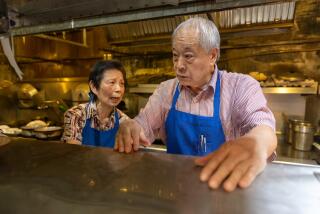Museum honors heritage of Chicago’s Chinese
- Share via
CHICAGO — With $1,000 and a stubborn desire to build a museum for Chinese Americans, Chuimei Ho and five others took their message to the streets, speaking at small gatherings about the rich history of Chicago’s Chinatown.
“They were free, and we wanted to show we were serious about Chinatown history,” Ho said. “And I guess we found the right notes to sing.”
Their monthly lectures led to donations of money, a building and antiques from local families.
Three years and $1 million later, the Chinese-American Museum of Chicago opened its doors inside a former wholesale warehouse in mid May.
The museum’s first exhibit, “Paper Sons: Chinese in the Midwest, 1870-1945,” introduces visitors to the history of Chinatown and the Chinese Americans who settled there. It tells their story through immigration papers, a sugar bowl from one of Chicago’s first Chinese restaurants, a replica of a Chinese laundry, inlaid rosewood chairs and about 150 photographs.
“This is a sampling dish,” said Ho, the museum’s president.
The exhibit presents portions of future shows the museum hopes to offer. It also tosses in personal stories of local Chinese Americans.
“One of the nice things about this community is that they have stories to tell,” said Ben Bronson, curator of Asian archeology at Chicago’s Field Museum, who also acts as an advisor for the new museum.
The museum is reaching out to its neighbors as it tells those stories: Along with Chinese and English, many of the exhibit’s descriptions are in Spanish, a feature the museum hopes will attract visitors from the largely Latino Pilsen neighborhood.
Several cultural museums have opened in Chicago’s ethnic neighborhoods over the years, including the Polish Museum of America, the DuSable Museum of African-American History and the Ukrainian National Museum of Chicago.
Toni Callas of the Hellenic Museum and Cultural Center in Chicago’s Greektown, which first opened in 1992, said many of the museums work together to share fundraising and exhibit ideas.
“We’re all built by the labor of people who are dedicated and devoted to perpetuating our heritage,” Callas said.


